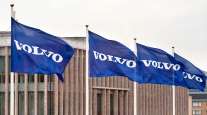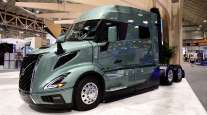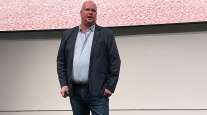Notebook: Volvo Connects Ocean With Trucking, Touts Growing Market Share
EDITOR’S NOTE: Additional coverage from this event will be included in the May 25 print edition of Transport Topics.
NEWPORT, R.I. — Trucking and an ocean race may not immediately seem like a natural combination. However, the two have proved to be a perfect match.
“There is a lot of common ground,” said Göran Nyberg, president of Volvo Trucks in North America.
Besides environmental and safety awareness, and the high-tech performance of their respective vehicles, the global reach of the race also fits well with the company’s brand strategy for trucks, he said.
Held every three years, the Volvo Ocean Race is considered one of the world’s most difficult endurance contests. With no prize money offered, sailing teams visit 11 ports during nine stages. It started in Spain in October and will finish mid-June in Gothenburg, Sweden, the home country of Volvo AB.
IMPROVED FUEL ECONOMY: Volvo touts gains in 2016 trucks
GHG CONCERNS: Volvo execs worried about government proposal
Volvo Trucks invited several hundred dealers, customers and employees in mid-May to take part in the festivities here, the only North American stop of the race.
Where trucks and water meet. @VolvoTrucksNA @TransportTopics #trucking pic.twitter.com/PsV7rSYGp5
— Neil Abt_TT (@NeilAbt) May 15, 2015
Perhaps surpassing the company’s excitement of the race itself was the host city, where welcoming signs mentioning Volvo seemed just about everywhere. U.S. Sen. Sheldon Whitehouse and Rhode Island Gov. Gina Raimondo were among dignitaries who spoke at a kickoff dinner for the company and guests May 14.
A racing village at Fort Adams State Park showed Volvo trucks and a close-up glimpse of the boats. At the end of the festivities, the six competing teams departed for the next stop: Portugal.
•Volvo Group hosted its Ocean Summit on Marine Debris in an effort to highlight a growing crisis.
“Our biggest challenge in fighting the pollution of the oceans is ignorance,” said Knut Frostad, CEO of the Volvo Ocean Race. “Our sailors experience this every day at sea, and I am honored to be part of the Ocean Summit to help bring more attention to a growing catastrophe that is the responsibility of all of us to reverse.”
•Volvo Trucks said it finished April with year-to-date market share records of 12.5% in the United States and 16.7% in Canada. That is a slight uptick from 12.4% at the same time a year ago in the United States, according to WardsAuto.
Sales momentum has continued into May, and its proprietary powertrain and I-Shift automatic transmission penetration continues to grow steadily, said Magnus Koeck, vice president of marketing.
•Volvo anticipates expanding to 400 dealer locations in North America by the end of this year, up from about 340.
Nyberg said much of the growth is coming from existing dealers adding locations — “a good sign franchise holders believe in the future.”
•Volvo expects to announce this summer additional partners that can provide fleets with integrated management services that use factory-installed telematics hardware.
Last year, Volvo and sister firm Mack Trucks announced initial partnerships with Telogis.
Rich Ferguson, a senior vice president with Volvo Group, said fleets want to avoid monthly fees and instead want all charges to be rolled into the initial truck purchase.
•The truck maker is moving forward with its effort to bring dimethyl ether to market, said Susan Alt, Volvo Group’s senior vice president of public affairs.
The company in 2013 projected it could begin selling DME-powered trucks as early as 2015, but that timeframe has been pushed back.
Alt said Volvo continues to evaluate how DME-powered engines operate in different climates, jesting that Sweden and Texas are very different. DME can be made from a number of feedstocks such as food, animal and agricultural waste as well as natural gas.
•The electronic stability control mandate that should be out within the next few months is a case where the industry “has fought hard to get the rule done right,” said Tony Greszler, a vice president with Volvo Group.
“I think they listened to us,” he said.
He said there’s potential for concern as California looks to expand its onboard diagnostics rule and if the state or Environmental Protection Agency attempts to move forward on even lower nitrogen oxide emissions.
“We are splitting zero into a smaller number,” Greszler said.




